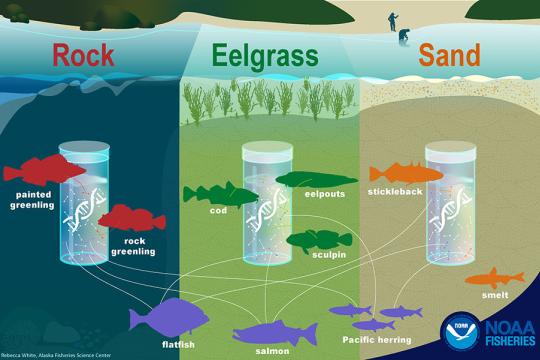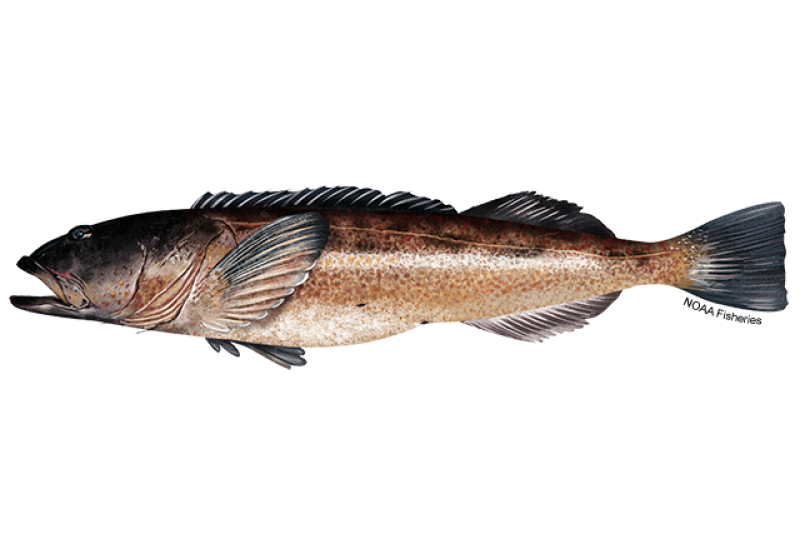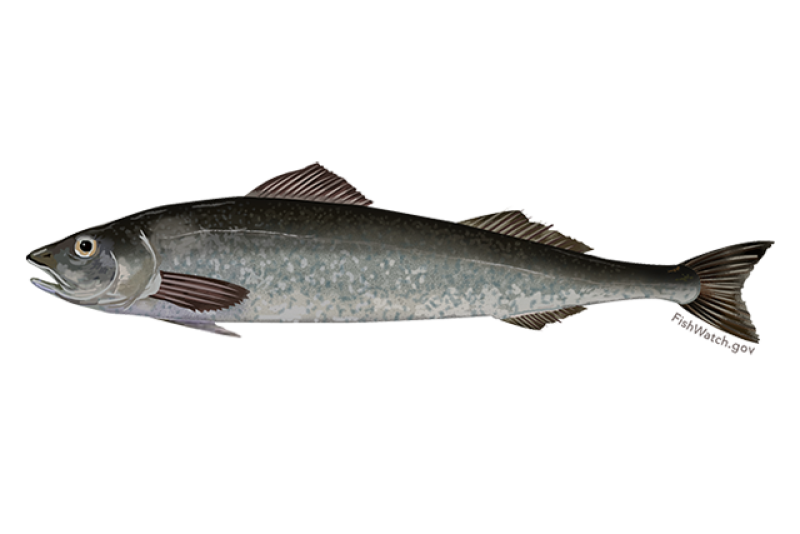 Lingcod. Credit: NOAA Fisheries
Lingcod. Credit: NOAA Fisheries
Lingcod. Credit: NOAA Fisheries
About the Species
 Lingcod. Credit: NOAA Fisheries
Lingcod. Credit: NOAA Fisheries
Lingcod. Credit: NOAA Fisheries
U.S. wild-caught lingcod is a smart seafood choice because it is sustainably managed and responsibly harvested under U.S. regulations.

Population
The stocks are not overfished.

Fishing Rate
Not subject to overfishing.

Habitat Impact
Time and area closures and gear restrictions protect habitats that are affected by some types of fishing gear used to harvest lingcod.

Bycatch
Regulations prohibit fishing in certain areas to protect sensitive fish populations.
Population Status
- There are two stocks of lingcod: Northern Pacific coast and Southern Pacific coast. According to the most recent stock assessments:
- The Northern Pacific stock is not overfished (2021 stock assessment), and not subject to overfishing based on 2022 catch data. Summary stock assessment information can be found on Stock SMART.
- The Southern Pacific stock is not overfished (2021 stock assessment), and not subject to overfishing based on 2022 catch data. Summary stock assessment information can be found on Stock SMART.
Appearance
- Lingcod are dark gray, brown, or greenish on the back with some copper-colored mottling or spotting along the upper back.
- Nicknamed “buckethead,” the lingcod has a large head and mouth, and 18 large, sharp teeth.
- Lingcod have long bodies that narrow toward the tail.
Biology
- Lingcod grow quickly, up to 5 feet and 80 pounds, and can live more than 20 years.
- Males sexually mature when they are about 2 years old and almost 20 inches long.
- Females are able to reproduce when they are 3 years old and 30 inches long.
- In late fall, male lingcod gather and become territorial over areas suitable for spawning, usually shallow, rocky habitats.
- Mature females are rarely seen at these spawning grounds. Scientists believe that the females briefly visit these spawning areas during winter and spring and only stay long enough to deposit their eggs in crevices and under ledges.
- Males guard the nests for 8 to 10 weeks until the eggs hatch. The presence of a male to guard the nest from predators appears essential for successful spawning. If something happens to the male, an unguarded nest can be decimated within 48 hours by feeding rockfish, starfish, sculpins, kelp greenling, and cod.
- Larvae feed on zooplankton (tiny floating animals), including krill and larval crustaceans such as lobster and crab. Juveniles feed on small fish.
- Adults are aggressive predators and feed primarily on bottom-dwelling fish (including smaller lingcod), squid, octopi, and crab.
- Marine mammals, sharks, and larger lingcod prey on juvenile and adult lingcod.
Where They Live
Range
- Lingcod are found from Kodiak Island in the Gulf of Alaska down to Baja California, but they’re most abundant near British Columbia and Washington.
Habitat
- Larvae live near the surface of the ocean. Juveniles settle on nearshore sandy ocean bottoms near eelgrass or kelp beds.
- Young adults and adults move to rocky habitats or seaweed, kelp, and eelgrass beds, where food is abundant.
- Male lingcod don’t generally move far from where they’re born, but researchers have found that immature fish sometimes migrate more than 60 miles and females migrate seasonally to spawn.
Fishery Management
- NOAA Fisheries and the Pacific Fishery Management Council manage the lingcod fishery on the West Coast.
- Managed under the Pacific Coast Groundfish Fishery Management Plan:
- Size limits and trip limits
- Certain seasons and areas are closed to fishing.
- Gear restrictions help reduce bycatch and impacts on habitat.
- A trawl rationalization catch share program includes:
- Catch limits based on the health of each fish stock and divided into shares that are allocated to individual fishermen or groups.
- Provisions that allow fishermen to decide how and when to catch their share.
- The State of Alaska manages the lingcod fishery in both state and federal waters in Alaska through the Alaska Department of Fish and Game Commercial Fisheries Regulations for Lingcod. Regulations include:
- Closing the fishery during spawning and nesting seasons to protect spawning female lingcod and nest-guarding male lingcod.
- Limits on the minimum size of fish that can be caught to protect immature fish from being harvested and allow fish to spawn at least once before being subject to harvest.
- Restricting catch through catch and bycatch quotas.
Harvest
- Commercial fishery:
- In 2023, commercial landings of lingcod totaled 2 million pounds and were valued at $2.8 million, according to the NOAA Fisheries commercial fishing landings database.
- Gear types, habitat impacts, and bycatch:
- On the West Coast, lingcod are typically harvested with other groundfish in the trawl fishery.
- Lingcod are also harvested incidentally in bottom longline and salmon troll fisheries.
- Trawls that are used to harvest lingcod can contact the ocean floor and impact habitats, depending on the makeup of the ocean bottom and the size of the gear.
- Trawls cause minimal damage when targeting lingcod over soft, sandy, or muddy ocean bottoms.
- Some areas are closed to certain gear types to protect sensitive habitat and species.
- Area closures, reduced trip limits, non-retention rules, gear restrictions, and variable catch limits are used to help minimize impact to overfished rockfish species and prevent bycatch.
- Charterboat fishermen in Washington have successfully used alternate bait (large flatfish) to reduce yelloweye rockfish bycatch when targeting lingcod.
- In Alaska, lingcod have been harvested for centuries by the indigenous coastal populations of Southeast, Southcentral, and Western Alaska.
- Lingcod were traditionally caught for subsistence use with hooks made of wood or bone.
- Today, lingcod are still fished for subsistence use but are also harvested in commercial fisheries in southeast Alaska with longlines, trolls, and jigs.
- Recreational fishery:
- Recreational fishing for lingcod occurs on the West Coast and Alaska.
- In 2023, recreational anglers landed 1.3 million pounds of lingcod, according to the NOAA Fisheries recreational fishing landings database.
- Due to high levels of yelloweye rockfish bycatch in West Coast hook-and-line recreational fisheries, recreational harvest needs to be carefully managed.
- Fish must be a certain size to be retained, and there are limits on the number of fish that sport fishermen can keep each day.
- In Alaska recreational fishing for lingcod is closed during spawning and nesting seasons.
Scientific Classification
- Lingcod are found from Kodiak Island in the Gulf of Alaska down to Baja California, but they’re most abundant near British Columbia and Washington.
- Larvae live near the surface of the ocean. Juveniles settle on nearshore sandy ocean bottoms near eelgrass or kelp beds.
- Young adults and adults move to rocky habitats or seaweed, kelp, and eelgrass beds, where food is abundant.
- Male lingcod don’t generally move far from where they’re born, but researchers have found that immature fish sometimes migrate more than 60 miles and females migrate seasonally to spawn.
Fishery Management
- NOAA Fisheries and the Pacific Fishery Management Council manage the lingcod fishery on the West Coast.
- Managed under the Pacific Coast Groundfish Fishery Management Plan:
- Size limits and trip limits
- Certain seasons and areas are closed to fishing.
- Gear restrictions help reduce bycatch and impacts on habitat.
- A trawl rationalization catch share program includes:
- Catch limits based on the health of each fish stock and divided into shares that are allocated to individual fishermen or groups.
- Provisions that allow fishermen to decide how and when to catch their share.
- The State of Alaska manages the lingcod fishery in both state and federal waters in Alaska through the Alaska Department of Fish and Game Commercial Fisheries Regulations for Lingcod. Regulations include:
- Closing the fishery during spawning and nesting seasons to protect spawning female lingcod and nest-guarding male lingcod.
- Limits on the minimum size of fish that can be caught to protect immature fish from being harvested and allow fish to spawn at least once before being subject to harvest.
- Restricting catch through catch and bycatch quotas.
Harvest
- Commercial fishery:
- In 2023, commercial landings of lingcod totaled 2 million pounds and were valued at $2.8 million, according to the NOAA Fisheries commercial fishing landings database.
- Gear types, habitat impacts, and bycatch:
- On the West Coast, lingcod are typically harvested with other groundfish in the trawl fishery.
- Lingcod are also harvested incidentally in bottom longline and salmon troll fisheries.
- Trawls that are used to harvest lingcod can contact the ocean floor and impact habitats, depending on the makeup of the ocean bottom and the size of the gear.
- Trawls cause minimal damage when targeting lingcod over soft, sandy, or muddy ocean bottoms.
- Some areas are closed to certain gear types to protect sensitive habitat and species.
- Area closures, reduced trip limits, non-retention rules, gear restrictions, and variable catch limits are used to help minimize impact to overfished rockfish species and prevent bycatch.
- Charterboat fishermen in Washington have successfully used alternate bait (large flatfish) to reduce yelloweye rockfish bycatch when targeting lingcod.
- In Alaska, lingcod have been harvested for centuries by the indigenous coastal populations of Southeast, Southcentral, and Western Alaska.
- Lingcod were traditionally caught for subsistence use with hooks made of wood or bone.
- Today, lingcod are still fished for subsistence use but are also harvested in commercial fisheries in southeast Alaska with longlines, trolls, and jigs.
- On the West Coast, lingcod are typically harvested with other groundfish in the trawl fishery.
- Recreational fishery:
- Recreational fishing for lingcod occurs on the West Coast and Alaska.
- In 2023, recreational anglers landed 1.3 million pounds of lingcod, according to the NOAA Fisheries recreational fishing landings database.
- Due to high levels of yelloweye rockfish bycatch in West Coast hook-and-line recreational fisheries, recreational harvest needs to be carefully managed.
- Fish must be a certain size to be retained, and there are limits on the number of fish that sport fishermen can keep each day.
- In Alaska recreational fishing for lingcod is closed during spawning and nesting seasons.
Scientific Classification
| Kingdom | Animalia | Phylum | Chordata | Class | Actinopterygii | Order | Scorpaeniformes | Family | Hexagrammidae | Genus | Ophiodon | Species | elongatus |
|---|
Last updated by NOAA Fisheries on 05/28/2025
Featured News
 All organisms shed DNA into the environment. Environmental DNA (eDNA) can be used to determine the identities of the fish species that are present at or near the time of sample collection. Credit: NOAA Fisheries
All organisms shed DNA into the environment. Environmental DNA (eDNA) can be used to determine the identities of the fish species that are present at or near the time of sample collection. Credit: NOAA Fisheries

Seafood Facts

Is Lingcod Sustainable?
U.S. wild-caught lingcod is a smart seafood choice because it is sustainably managed and responsibly harvested under U.S. regulations.
Availability
Year-round.
Source
U.S. wild-caught from Alaska to California.
Taste
A mild-tasting fish.
Texture
A tender fish with large flakes.
Color
Blue-green tint when raw, but is snow white once cooked.
Health Benefits
Lingcod is a good source of low-fat protein and is high in vitamin B12 and selenium.
Nutrition Facts
Servings: 1; Serving Weight: 100 g (raw); Calories: 85; Protein: 17.66 g; Total Fat: 1.06 g; Total Saturated Fatty Acids: 0.197 g; Carbohydrate: 0 g; Total Sugars: 0.11 g; Total Dietary Fiber: 0 g; Cholesterol: 52 mg; Selenium: 36.5 mcg; Sodium: 59 mgMore Information
Lingcod Recipes
Looking for some ways to add lingcod into your rotation? Browse these recipes for baked lingcod with sorrel, grilled lingcod, and more!

Last updated by NOAA Fisheries on 05/28/2025
Seafood News
 Credit: NOAA Fisheries and Partners
Credit: NOAA Fisheries and Partners
Part 2: Seafood Tips from the People Bringing You America's Seafood
 Commercial fishing boats lined up in Sitka, Alaska. Credit: Shutterstock.
Commercial fishing boats lined up in Sitka, Alaska. Credit: Shutterstock.
NOAA Fisheries Seeks Recommendations for Restoring American Seafood Competitiveness

Celebrate Seafood This Holiday Season

Part 1: Seafood Tips from the People Bringing You America's Seafood
Research
Southern California Shelf Rockfish Hook and Line Survey
The Hook and Line Survey uses rod and reel gear to sample fish in areas that are difficult to survey using traditional research trawl nets.
Aquaculture Science and Research on the West Coast
NOAA Fisheries’ Science has been fulfilling our legal mandate to address the environmental impacts of aquaculture.
Last updated by NOAA Fisheries on 05/28/2025


